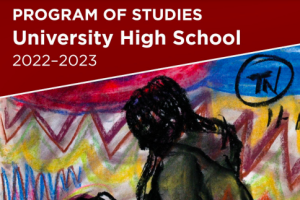History department offers flexibility, more options in new courses
Junior Michael Ewing portrays famous abolitionist David Walker during a roundtable discussion in an AT African American class Feb. 1.
February 2, 2022
To give students more course options and schedule flexibility, the history department has responded to student requests and overhauled its curriculum for the 2022-23 school year.
Once students have passed Early World History in tier one, they will have more flexibility and a wider breadth of courses to take in subsequent years.
Students will have the opportunity to take a variety of semester-long modern world history courses in the second tier. Some courses will be designated as Advanced Topics, while one class will let enrolled students opt into an AT version.
Six courses are available to request for the fall semester: Industrialism and Environmental Impacts I, 20th Century Latin American History, Modern World Religions I, AT Imperial Dreams Found and Lost, AT Modern European History I: Humanism to Liberalism, and AT Optional Worlds of Asia I. Spring semester offerings include Industrialism and Environmental Impacts II, 20th Century African Liberation, Modern World Religions II, AT Global Cold War, AT Modern European History II: Radicalism to EU Globalism, and AT Optional Worlds of Asia II.
Third tier courses will remain yearlong. In addition to U.S. History, AT U.S. History and AT African American History, the department is launching a new course, AT Latinx Histories.
Economics: Theory and Application will be offered as a yearlong course, relabeled to more accurately reflect the workload and rigor of the class. AT Comparative Politics and International Relations, and AT War and Violence in the Premodern World will each be offered in two parts over the two semesters.
The development of the new curriculum has been in process for a while, with encouragement from both the curriculum committee and history department.
The curriculum committee’s goal is to increase flexibility within student schedules.
“It’s been a long-term aspiration of the curriculum committee to increase the number of semester offerings in the entire school,” department chair Christy Gerst said. “Then students can mix and match between different departments.”
The choice to offer more semester-long courses has allowed the department to respond to concerns about student workloads.
“Students might need one semester AT and non-AT during the other semester depending on their extracurriculars,” Ms. Gerst said. “The new structure allows them to do that.”
The department wants to make more courses accessible to as many students as possible, which is why they’ve introduced the possibility of AT-optional courses.
“AT-optional courses allow students to have a discussion with their teacher at the beginning of the semester to decide if they want to take the course as an AT or not,” Ms. Gerst said.
When planning for the year ahead, history students can find more detailed descriptions of course workload can be found in the program of studies.
“Students should really look at the course descriptions, because we’ve tried to be more transparent about how much is going to be required,” history teacher Paul Horton said.
With three new history teachers this year, the department had a unique opportunity to incorporate each person’s expertise.
“We have three new hires, so as we came up with this new curriculum, we’ve been considering what their new areas of expertise are,” Ms. Gerst said. “This was something that we’ve been really pushing for. The issue came up within the very first and second department meetings of the year, and we had to move quickly to get it through the deadline process.”
However, Ms. Gerst also noted that this process began before the new hires arrived.
“The push isn’t just from outside though,” she said. “We’ve been considering how our existing faculty wants to grow, not just change from outside.”
The new curriculum was created with students’ requests and interests in mind.
“In developing the curriculum, we’ve been thinking about what is of particular interest and relevance to our students,” Ms. Gerst said. “Students have been asking us for certain classes, and we’re getting it done.”
Mr. Horton reiterated this sentiment, expressing his hope that students will pursue what they are passionate about.
“What we’re trying to do overall is to offer students a lot more choices,” Mr. Horton said, “and we hope that they will be interested in the topics and get away from the idea of taking a course because a certain teacher is teaching that course.”
Ms. Gerst expects students to react to the curriculum as positively as the department has.
“I hope that it gives students the flexibility they need and engages the interests they have,” Ms. Gerst said. “We’ve put a lot of work into it, and I hope it is well received for how hard we’ve been working on it.”





























































